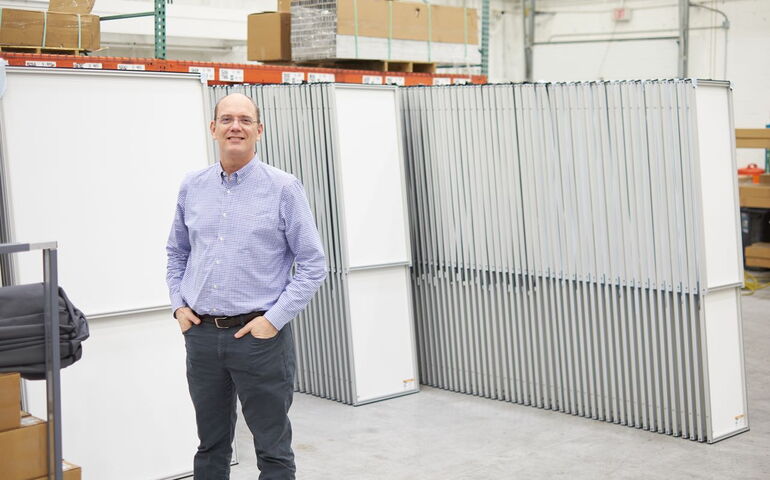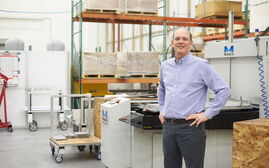
Processing Your Payment
Please do not leave this page until complete. This can take a few moments.
At Brunswick Landing, manufacturer STARC plans to build new plant
 Courtesy / STARC Systems
Chris Vickers, STARC Systems president and CEO, said a new 85,000-square-foot manufacturing and administrative facility at Brunswick Landing will support product line extensions and provide capacity needed to meet growing demand.
Courtesy / STARC Systems
Chris Vickers, STARC Systems president and CEO, said a new 85,000-square-foot manufacturing and administrative facility at Brunswick Landing will support product line extensions and provide capacity needed to meet growing demand.
With a revenue growth rate of 30% per year for the last five years, STARC Systems is aiming to keep up the momentum by building an 85,000-square-foot manufacturing and administrative facility at Brunswick Landing.
STARC makes temporary reusable wall systems for construction containment. The wall systems are designed to be reusable on hundreds of jobs over many years.
Starting in 2015 at TechPlace, Brunswick Landing’s technology incubator, the company has grown to 100 employees since its incubation. The company is approaching $40 million in revenue, and expects to continue adding 15% to 20% annually to its workforce in production, manufacturing management, sales, marketing and support areas.
Growth is propelled by strong organic demand from STARC’s customer base, new investments from Chicago-based North Branch Capital in 2023, and the introduction of three new product platforms in the last five years.
“This expansion is not just about increasing our manufacturing capacity; it’s also about creating opportunities for our team and contributing to the local economy,” said Chris Vickers, the company’s president and CEO.
The developer
The 85,000-square-foot manufacturing and administrative facility is being developed by Priority Real Estate Group for STARC as a long-term lease tenant.

Altogether, Priority owns and leases about $60 million worth of property at Brunswick Landing for a variety of customers. Over the years, Priority has permitted and sold about $80 million of development there.
STARC will be the anchor tenant in one of Priority’s latest developments, an industrial park that’s permitted overall for 250,000 square feet of space. The 85,000-square-foot building will include the ability add another 50,000 square feet, said Jim Howard, Priority Real Estate Group’s president and CEO.
Pending final approvals, the goal is to break ground late this summer and have it completed by the fall of 2025.
The facility will be on Admiral Fitch Drive in Priority Park. The expected cost is in the $12.5 million range, financed with cash and with a loan from Androscoggin Bank.
Priority engaged Canal 5 Studio in Portland and Lajoie Bros. of Augusta on architecture and construction design.
“We are pleased to be working with STARC Systems and look forward to having them as the anchor tenant at our new Brunswick Landing business park,” said Howard.
Brunswick Landing growth
Priority is one of a number of development partners that have allowed the authority to accelerate growth at the Landing.
“Priority has been a great partner in terms of developing some of the properties on Brunswick Landing,” said Jake Levesque, director of innovation and development for the Midcoast Regional Redevelopment Authority.
The authority oversees development of the Landing, which was the former Brunswick Naval Air Station.
Today, the Landing has over 150 companies and entities; 39 of those are currently at TechPlace, a technology incubator that has housed over 75 companies since its inception.
“Brunswick Landing is allowing for growth and accelerating these businesses that started out in TechPlace originally,” said Levesque.
Said Kristine Logan, the authority’s executive director, “MRRA has always been a big supporter and cheerleader of STARC Systems, from their startup days in TechPlace, through their growth into other buildings on the Landing.”
STARC expansion
For STARC, the expansion marks a significant milestone in the company’s growth, supporting its mission to serve numerous U.S. and international construction markets, including health care, airports, life sciences, commercial offices and data centers.
The expanded space will support product line extensions and provide the capacity needed to meet growing demand.
The company was founded in 2012 by Tim Hebert, a co-owner of Hebert Construction in Lewiston.
Hebert has told Mainebiz the idea for a better wall containment system was rooted in the work Hebert Construction did in hospitals and health care. He was concerned about the amount of dust and debris, and the time spent on erecting temporary containment on sensitive or patient-occupied health care renovation projects.
His concept was a modular, reusable temporary containment system that was quick and quiet to install.
In 2014, he hired Bruce Bickford, a mechanical engineer and product developer, as the company’s first employee. They prototyped and tested STARC’s initial product, RealWall. Their first significant sale was to Children’s Mercy Kansas City.
Additional hires and health care customers followed and production ramped up to meet increasing demand. In 2019, STARC introduced LiteBarrier as a lightweight containment category.
In 2020, as health care providers scrambled to manage skyrocketing caseloads, STARC’s walls were adopted by health systems that used the products to create airborne infection isolation rooms, anterooms and containment areas.
By 2021, the company’s customer base had grown to include not only the health care industry but also airports, data centers, universities and commercial office settings. It developed a third product, called FireblockWall, as a modular, reusable one-hour fire-rated temporary containment system.
The company calculates its products have prevented 90,546 tons of single-use drywall from going to landfills.
It has a national and international customer base.
The product is predominantly purchased by contractors for jobs they’re working on.
Quick assembly
“The panel system is delivered to the project site and they assemble it,” Vickers said.
A big part of the value equation is that the wall systems go up quickly and with none of the debris or disruption that is seen with conventional dry wall containment.
No tools are needed for assembly. Components clip together and the walls can telescope to a ceiling. The system can be freestanding or tied to a ceiling. When the project is done, they can be taken down, reconfigured and used for other projects.
“The reusability and reconfigurability on the project is a big advantage,” said Vickers. “It has the flexibility to go wherever necessary to help with an occupied renovation, keeping dust, debris, pathogens and noise from disturbing the occupied space.”
Team environment
Over the years, STARC’s expansion has resulted in various moves and more leases.
In 2017, it moved down the road from TechPlace to an 18,000-square-foot facility at 166 Orion St.
Then it leased an additional 50,000 square feet in a hangar at 112 Orion St. plus 3,000 square feet at 2 Pegasus St.
The plan is to keep the 18,000-square-foot lease and add the 85,000 square feet.
The new development will accommodate current and future growth and will provide a more efficient space that will accommodate more inventory and equipment such as computer numerical control cutting and bending machines, said Vickers.
Capacity in the new facility is expected to be $60 million to $70 million in annual revenue, compared with $40 million to $45 million now.
STARC has been hiring since its inception, said Vickers.
“In the past 12 months, we hired a significant number of people in administrative, sales and marketing roles and continued to add front line assembly folks in manufacturing,” he said.
The new facility will allow for consolidation of manufacturing, inventory and administration. Consolidation is expected to provide an operational advantage.
“Without this, we’d have to get more facilities for manufacturing to produce the increasing volume,” said Vickers. “One big advantage will be the improved interaction between manufacturing and other parts of the organization. Having that all in one place creates a much better team environment.”














0 Comments